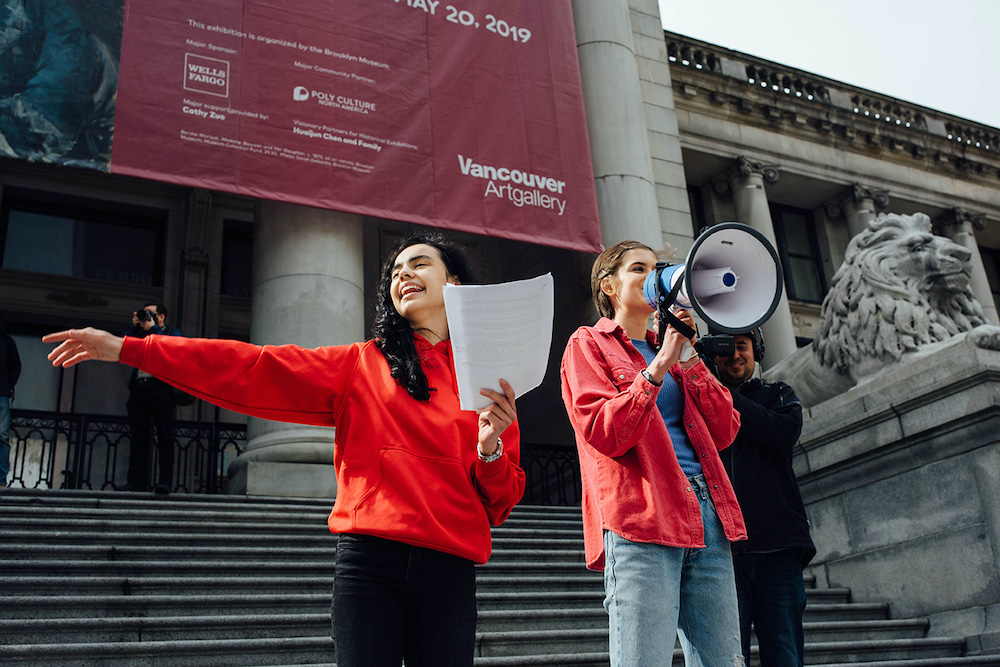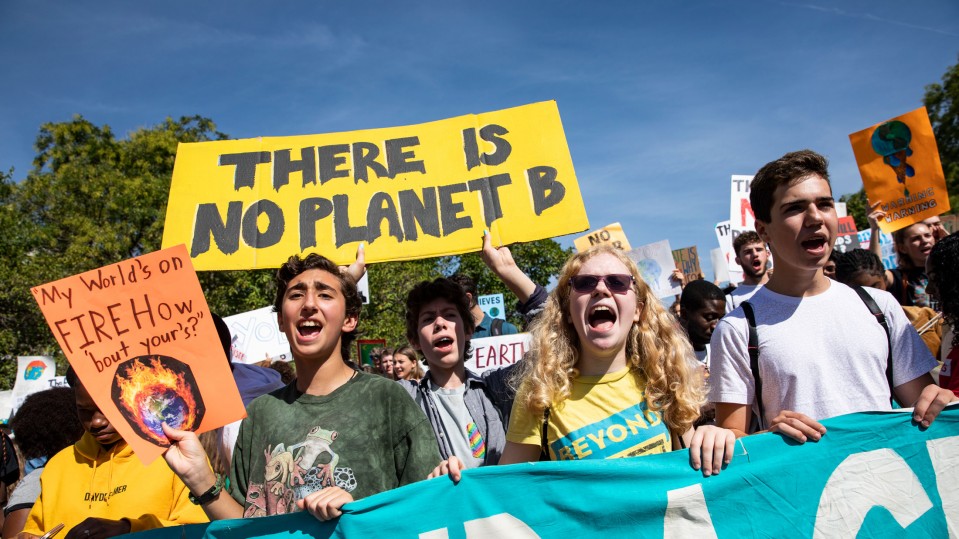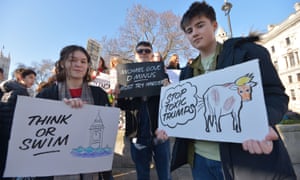Meet three young activists taking their elders to school on the climate crisis.

Learning by doing. Rebecca Hamilton (at right) speaking to climate strikers at the Vancouver Art Gallery on March 18, 2019. Photo by Jackie Dives.
On a Vancouver fall evening, a handful of teenagers met for dinner to make last-minute preparations for the climate strike they’d been planning for the next day. As they ate chili and peered at their event page on Facebook, they wondered how many would show up to join them when they walked out of classes and took to the streets.Our lineup of captivating speakers will explore this place we call home. Feb. 18 in Vancouver.
They’d organized a similar strike in May, and a few thousand people had turned out. But this one, slated for Sept. 27, felt different.
As Grade 12 student Naia Lee rode the 99 B-Line home from dinner that evening, she spied a stranger holding a large sign and asked if she would be striking. Yes, she would, and she was bringing her friends, too.
Later that night, 17-year-old Rebecca Hamilton was working on her speech when her mother guessed she might be addressing 40,000 people, even more. “Don’t talk about it,” she told her mom. “No, that’s crazy.”
The morning dawned clear and bright. As Hamilton approached city hall, where the march would begin, her SkyTrain car was jam-packed, and when she emerged from the station, the streets were teeming, a sea of people stretching across the Cambie Street Bridge.
The crowd was officially estimated to be 100,000. The teens put the number closer to 150,000. Either way, this would be one of the largest mass mobilizations in Vancouver’s history, linked with similarly huge protests in cities across the world over the past two years, coordinated by Global Climate Strikes and FridaysForFuture.
“We couldn’t even comprehend the amount of people there,” says Hamilton, thinking back at the rush she felt joining the meandering mass as it coursed through downtown Vancouver.
Samantha Lin, a Grade 12 student, remembers being shocked at what she’d helped pull off. “There wasn’t really any precedent for what was going to happen just the next day. There was nothing to prepare me in my mind for the amount of people that I would see.”
Lee, Hamilton and Lin — and the other youth climate activists they organize with — call themselves the Sustainabiliteens. In the year they’ve been working together, they have organized classroom strikes, occupied a B.C. cabinet minister’s office, mounted a die-in outside the Vancouver offices of fossil fuel company Teck Resources Limited and staged funerals for their future, one of them outside of an international fracked gas conference.
Their lives are busy with classes and exams, meetings, and interviews with journalists. They could be playing volleyball, dancing, or, as Lee laughs, “spending a lot more time with my family.”
But “the urgency of the climate crisis,” says Lin, “wasn’t something that was going to wait. And I didn’t see any action happening from governments.”
Hamilton finds it “really confusing” to see so many adults complacent in the face of the climate crisis. “People go on just living their daily lives, and the politicians talking about other things, and we go to school and learn math, and nobody’s really acknowledging that we’re living in a really pivotal time in human history.”
She knew she had to do something. “I had this one moment when I realized, if we can’t live on our planet, nothing else matters.”
Even well-meaning environmental efforts at school didn’t seem to match the urgency students like Lin feel. Growing up in Vancouver, she came to appreciate the outdoors and the beauty of nature. As she grew older, she became more aware of the massive levels of waste generated by our economy. “Just seeing our overconsumption, our world system. We’re not sustainable.”
Lin started working and organizing events around sustainability with people in her school, but she felt like a lot of it had what she called a “very non-urgent” perspective on the climate crisis. “It was very ‘let’s reduce waste’ or ‘let’s think of how we can make changes in our school’ instead of the climate justice lens that we’re looking at it through now.”
Hamilton agrees with the sentiment. “It was really hard to figure out how to get involved because all the youth groups I could find were talking about, like, recycling.”
In spring 2018, Lin and Hamilton crossed paths at a climate activism workshop. After the school term and over the summer, the two attended a climate activism camp. A friendship was born.
In fall 2018, a teen emerged on the world stage who projected a fiercely pragmatic, the-time-is-now message about the climate crisis. She was 15-year-old Greta Thunberg, gaining notoriety for spending her school days climate striking outside the Swedish parliament. Thousands of daring Australian students, too, were marching through the streets of major cities. They paid no mind when a federal cabinet minister scolded them, saying their futures would see them “up in a line asking for a handout, not actually taking charge of your life and getting a real job.”
“There was just a great public consciousness around the climate crisis and just how much of a crisis it was,” Lin recalls.
And it was inspiring. “My parents have always raised me to be very aware of what’s going on. And not only to be aware, but also to understand that I need to care about what’s happening,” Lee says. “It was just a matter of time before I started to really take that on myself.”
Lee had already been involved in a housing justice initiative and also runs a gender equity club with one of her best friends from school. About this time last year, she was walking out of school in support of the Wet’suwet’en land defenders in opposition to the Coastal GasLink LNG pipeline in northern B.C. when she met a bunch of teens who had gone to the December strike. She became friends with Hamilton on Facebook and joined the Sustainabiliteens.
Lee is quick to credit members of older generations for preparing the way. “It’s the work of frontline communities and most-affected individuals who’ve started this movement and who have been pushing it for decades,” she says.
“This isn’t a movement that we started,” agrees Hamilton. “We’re really following in the footsteps of Indigenous land defence, which has been going on for 500 years. And the continued assertion of Indigenous presence on their land has really stemmed, I think, what could be a much worse situation and has halted a lot of destruction.”
Hamilton used to think about climate change as a really scary thing that is coming at all of us. It is, but now she understands that “the big and scary thing” had come for some people already.
For some it has meant surviving historic-level floods. Others have experienced the melting away of their previously frozen homelands. Others find themselves on the frontlines of forest fires. For these people, many of them Indigenous, the climate crisis isn’t about saving the future, it’s already a matter of life and death.
You can’t separate environmentalism and climate justice from advocating for human rights or issues that affect marginalized communities, notes Lee. Climate change “exacerbates other issues, and other issues exacerbate climate change,” she says. “We’ve just really tried to make that a core pillar of how Sustainabiliteens interacts and engages with the movement.”
Hamilton would like older people who find teenagers like her inspiring to not assume “OK, the kids have got it from here.”
“The point of us being inspiring is for you to act. It’s not about just us doing our thing and doing it well,” she says.
A week before the Sept. 27 strike, Thunberg delivered a speech to a United Nations summit that rang in the ears of world leaders. “How dare you,” she’d said. “You have stolen my dreams and my childhood with your empty words. And yet, I’m one of the lucky ones.”
“The eyes of all future generations are upon you. And if you choose to fail us, I say we will never forgive you. We will not let you get away with this. Right here, right now is where we draw the line,” she said. The world leaders applauded. None of the major goals of the summit, nor any of those required to reduce carbon emissions in any meaningful way, were pledged.
Right now, Hamilton says, adults need to be speaking up in their communities and organizations they’re a part of, working to transform every level of society and transition to a post carbon future. They should ask themselves, “What does this transition look like for our industry?” And, “Is what we’re doing in alignment with the recognition that we’re living in a climate crisis?”
The Sustainabiliteens are trying to move beyond just mobilizing people for strikes, and into creating long-term organizing structures. The group set up a school leads program to ensure high-school students across Vancouver have access to a strong community that is taking action on climate justice in their schools.
In October, the group organized their ninth climate strike, a stop on Thunberg’s world tour. Recently, the teens helped launch a walkout in solidarity with the Wet’suwet’en land defenders.
The three climate activists have grown to be very close friends in the year they’ve been organizing together. They are thinking of taking a gap year to travel B.C. and meet other communities of climate strikers.
“What’s important in a group, I think, is having trust between everybody, and having relationships that extend outside of organizing,” Hamilton says.
“I’m really grateful, having met Naia and Rebecca because they are two of the closest friends that I have to this day,” says Lin.
“And I’m really grateful for them, because I know that there’s a certain sense of shared responsibility that we all feel and that’s the reason why we organize together. We just very much enjoy our time together and I’ve come to really trust them as people and just trust their intentions.” ![]() SOURCE
SOURCE





